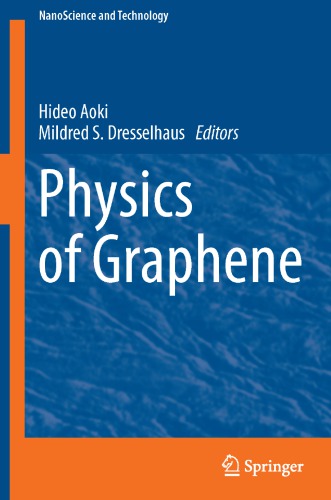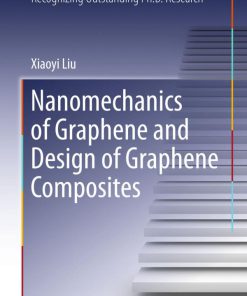The physics of graphene 2nd Edition by Mikhail Katsnelson ISBN 1108471641 9781108471640
$50.00 Original price was: $50.00.$25.00Current price is: $25.00.
The physics of graphene 2nd Edition by Mikhail I. Katsnelson – Ebook PDF Instant Download/Delivery: 1108471641, 978-1108471640
Full download The physics of graphene 2nd Edition after payment

Product details:
ISBN 10: 1108471641
ISBN 13: 978-1108471640
Author: Mikhail I. Katsnelson
The physics of graphene 2nd Table of contents:
1. The Electronic Structure of Ideal Graphene
1.1 The Carbon Atom
1.2 π States in Graphene
1.3 Massless Dirac Fermions in Graphene
1.4 The Electronic Structure of Bilayer Graphene
1.5 Multilayer Graphene
2. Electron States in a Magnetic Field
2.1 The Effective Hamiltonian
2.2 Landau Quantization for Massless Dirac Fermions
2.3 Topological Protection of the Zero-Energy States
2.4 Semiclassical Quantization Conditions and Berry’s Phase
2.5 Landau Levels in Bilayer Graphene
2.6 Trigonal Warping Effects in Bilayer Graphene
2.7 Unified Description of Single-Layer and Bilayer Graphene
2.8 Magnetic Oscillations in Single-Layer Graphene
2.9 The Anomalous Quantum Hall Effect in Single-Layer and Bilayer Graphene
2.10 Effects of Smooth Disorder and External Electric Field on Landau Levels
3. Quantum Transport via Evanescent Waves
3.1 Zitterbewegung as Intrinsic Disorder
3.2 Landauer-Formula Approach
3.3 Conformal Mapping and Corbino Geometry
3.4 Aharonov-Bohm Effect in Undoped Graphene
4. The Klein Paradox and Chiral Tunneling
4.1 The Klein Paradox
4.2 The Massless Case: Role of Chirality
4.3 Klein Tunneling in Single-Layer Graphene
4.4 Klein Tunneling for Smooth Potential Barriers and Magnetic Fields
4.5 Negative Refraction and Veselago Lenses for Electrons in Graphene
4.6 Klein Tunneling and Minimal Conductivity
4.7 Chiral Tunneling in Bilayer Graphene
5. Edges, Nanoribbons, and Quantum Dots
5.1 The Neutrino Billiard Model
5.2 Generic Boundary Conditions: Valley Mixing
5.3 Boundary Conditions for Terminated Honeycomb Lattice
5.4 Electronic States of Graphene Nanoribbons
5.5 Conductance Quantization in Graphene Nanoribbons
5.6 Band Gap in Graphene Nanoribbons with Generic Boundary Conditions
5.7 Energy Levels in Graphene Quantum Dots
5.8 Edge States in Magnetic Fields and the Anomalous Quantum Hall Effect
5.9 Spectral Flow for Massless Dirac Fermions
6. Point Defects
6.1 Scattering Theory for Dirac Electrons
6.2 Scattering by Constant Potential Regions
6.3 Scattering Theory for Bilayer Graphene in Parabolic-Band Approximation
6.4 General Theory of Defects in Honeycomb Lattices
6.5 Vacancies in Graphene
6.6 Adsorbates on Graphene
6.7 Scanning Tunneling Microscopy of Point Defects on Graphene
6.8 Long-Range Interaction Between Adatoms on Graphene
7. Optics and Response Functions
7.1 Light Absorption by Dirac Fermions: Fine-Structure Constant Visualization
7.2 Optics of Dirac Fermions: Pseudospin Precession Formalism
7.3 Many-Body Corrections to Universal Optical Conductivity: Phenomenological Approach
7.4 Magneto-Optics of Dirac Fermions
7.5 Optical Properties of Graphene Beyond Dirac Approximation
7.6 Dielectric Function of Dirac Fermions
7.7 Static Screening
7.8 Plasmons
7.9 Transverse Response Functions and Diamagnetic Susceptibility
8. The Coulomb Problem
8.1 Scattering of Dirac Fermions by Point Charges
8.2 Relativistic Collapse for Supercritical Charges
8.3 Nonlinear Screening of Charge Impurities
8.4 Interelectron Coulomb Interaction and Renormalization of the Fermi Velocity
9. Crystal Lattice Dynamics, Structure, and Thermodynamics
9.1 Phonon Spectra of Graphene
9.2 Theory of Elasticity for Thin Plates
9.3 Statistical Mechanics of Flexible Membranes
9.4 Scaling Properties of Membranes and Intrinsic Ripples in Graphene
9.5 Self-Consistent Screening Approximation
9.6 Thermodynamic Properties of Graphene
9.7 Mechanical Properties of Graphene
9.8 Raman Spectra of Graphene
10. Gauge Fields and Strain Engineering
10.1 Strain-Induced Pseudomagnetic Fields
10.2 Pseudomagnetic Fields from Frozen Ripples
10.3 Pseudomagnetic Fields of Ripples: In-Plane Relaxation Effects
10.4 Zero-Field Quantum Hall Effect via Strain Engineering
10.5 Pseudo-Aharonov-Bohm Effect and Transport Gap in Suspended Graphene
10.6 Gap Opening by Strain and Electric Field Combination
11. Scattering Mechanisms and Transport Properties
11.1 Semiclassical Boltzmann Equation and Applicability Limits
11.2 Kubo-Nakano-Mori Formula for Resistivity
11.3 Scattering Mechanisms in Graphene on Substrate
11.4 Intrinsic Mobility and Transport Properties of Suspended Graphene
11.5 Edge Scattering of Electrons in Graphene
11.6 Nonlocal Transport in Magnetic Fields
11.7 Beyond Boltzmann Equation: Localization and Antilocalization
11.8 Hydrodynamics of Electron Liquid in Ultra-Pure Graphene
12. Spin Effects and Magnetism
12.1 General Remarks on Itinerant-Electron Magnetism
12.2 Defect-Induced Magnetism in Graphene
12.3 Magnetic Edges
12.4 Spin-Orbit Coupling
12.5 Spin Relaxation Due to Edge Scattering
13. Graphene on Hexagonal Boron Nitride
13.1 Motivation: Ripples and Puddles
13.2 Geometry and Physics of Moiré Patterns
13.3 Zero-Mass Lines and Minimal Conductivity
13.4 Berry Curvature Effects
13.5 Electronic Structure of Moiré Patterns
13.6 Magnetic Bands in Graphene Superlattices
14. Twisted Bilayer Graphene
14.1 Geometry and Atomic Structure
14.2 Dodecagonal Graphene Quasicrystal
14.3 Electronic Structure of Twisted Bilayer Graphene
15. Many-Body Effects in Graphene
15.1 Screening and Effective Interactions
15.2 Mapping onto the Hubbard Model
15.3 Renormalization of Electron Spectrum Beyond Dirac Approximation
15.4 Quantum Monte Carlo Results
15.5 Many-Body Renormalization of Minimal Conductivity
People also search for The physics of graphene 2nd:
the physics and chemistry of graphene on surfaces
what are the major functions of graphene
how much force can graphene withstand
benefits of graphene
why is graphene harder than graphite
Tags:
Mikhail Katsnelson,physics,graphene 2nd
You may also like…
Romance - Paranormal Romance
Rage of Storms The Academy of Elements 3 1st Edition by Kat Adams B084Z2RBXJ
Romance - Contemporary Romance
Let s Taco Bout Love Man of the Month May 1st Edition by Kat Baxter ASIN B08TDPK7XS
Reference - School Guides & Test Preparation
Computers - Programming
Technique - Military equipment: Weapon
Technique - Military equipment: Weapon
Biology and other natural sciences - Molecular












